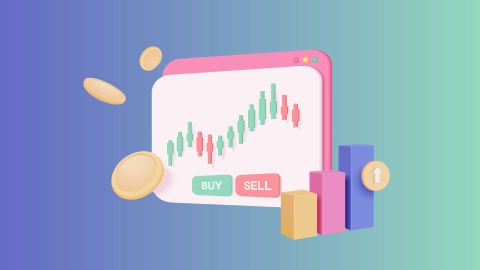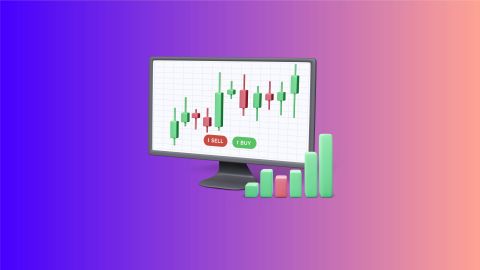Trading involves the buying and selling of shares with the goal of profiting from price fluctuations. Stock traders engage in the active management of their portfolios, executing trades based on market conditions, technical analysis, and other short-term indicators.
One common form of stock trading is day trading, where traders open and close positions within the same trading day, seeking to capitalise on intraday price movements. Day traders carefully analyse stock charts, patterns, and trading volumes to make informed decisions on when to enter and exit positions.
Swing trading is another stock trading strategy, involving holding positions for a few days to weeks to capture short to medium-term price movements. Swing traders typically aim to benefit from market trends and momentum during these timeframes.
Stock trading also encompasses other approaches, such as momentum trading, where traders focus on stocks experiencing significant price momentum, and scalping, a strategy centred around making small, quick profits from minor price changes.
While stock trading provides opportunities for quick profits, it comes with inherent risks. Prices can be influenced by various factors, including company news, economic indicators, and global events. As a result, successful stock trading requires a solid understanding of market dynamics, risk management strategies, and the ability to adapt to rapidly changing conditions.
Plan your trades with the brokerage calculator.
Types of trading
Let us explore the different types of trading:
1. Day trading
- Definition: Involves opening and closing positions within the same trading day.
- Strategy: Traders analyse stock charts, patterns, and volumes to capitalise on intraday price movements.
2. Swing trading
- Definition: Involves holding positions for a few days to weeks, capturing short to medium-term price movements.
- Strategy: Focuses on market trends and momentum during these timeframes.
3. Momentum trading
- Definition: Traders focus on stocks experiencing significant price momentum.
- Strategy: Capitalising on the continuation of strong price trends for potential quick profits.
4. Scalping
- Definition: A strategy centred around making small, quick profits from minor price changes.
- Strategy: Involves numerous trades in a day, taking advantage of short-term price fluctuations.
What is investing in the stock market?
The primary aim of investing is to capitalise on the sustained growth of a company and the appreciation of its stock value over time within the Indian market dynamics.
Investors often rely on fundamental analysis, meticulously examining a company's financial health, earnings reports, management competence, and competitive standing in the market. This approach seeks to identify stocks with robust underlying fundamentals and the potential for consistent growth.
Dividends also play a crucial role in investment strategies within the stock market. Many investors prefer stocks that provide regular dividend payouts, offering a reliable income stream. Companies with a track record of stable earnings and a commitment to sharing profits with shareholders are often favoured by Indian investors.
While investing in the Indian stock market generally involves lower day-to-day involvement compared to trading, it demands patience and a long-term outlook. The value of investments may experience short-term fluctuations, but investors rely on the resilience of the market and the potential for their chosen companies to flourish over time.
Investment Styles
Investors typically adopt one of the following investment styles based on their risk appetite, market outlook, and financial goals.
- Growth Investing: Growth investors focus on companies that show strong potential for revenue and earnings expansion. They typically invest in stocks with high price-to-earnings ratios, expecting long-term capital appreciation. Growth investing often involves higher risk, as these stocks can be volatile.
- Value Investing: Value investors look for stocks that are undervalued compared to their intrinsic worth. They seek companies with strong fundamentals but temporarily low stock prices. This style requires patience, as value stocks may take time to realise their true market potential.
- Income Investing: Income investors prioritise steady cash flow over capital appreciation. They invest in dividend-paying stocks, bonds, or other income-generating assets. This approach is ideal for those seeking a regular income stream, such as retirees.
Types of investing
There are several common investing approaches that help investors choose suitable methods for their goals.
1. Value investing
- Definition: Investors seek stocks that are undervalued based on fundamental analysis.
- Strategy: Focus on the intrinsic value of stocks, considering financial health, earnings, and competitive standing.
2. Dividend investing
- Definition: Investors prioritise stocks that provide regular dividend payouts.
- Strategy: Seeking companies with stable earnings and a commitment to sharing profits with shareholders.
3. Growth investing
- Definition: Investors target stocks with strong growth potential in terms of revenue and earnings.
- Strategy: Emphasis on companies expected to outperform the market over the long term.
4. Income investing
- Definition: Investors focus on generating a regular income stream from their investments.
- Strategy: Often involves securities that pay interest or dividends, providing a reliable income source.
5. Index fund investing
- Definition: Involves investing in a diversified portfolio that mirrors a market index.
- Strategy: Passive approach, aiming to replicate the overall market performance.
Main Differences between Investing and Trading
Let us understand the key differences between trading and investing:
Category
|
Trading
|
Investing
|
Time Horizon
|
Short-term focus, with transactions often executed within minutes or hours.
|
Long-term perspective, holding assets for years or decades.
|
Goals and Objectives
|
Aims to generate quick profits from short-term price movements.
|
Focuses on long-term wealth creation, capital appreciation, and dividend income.
|
Risk Tolerance
|
Higher risk due to short-term market volatility and frequent use of leverage.
|
Lower long-term risk, aiming to ride out short-term fluctuations for stable growth.
|
Involvement and Monitoring
|
Requires active monitoring of market trends and indicators throughout the day.
|
Less day-to-day involvement, with periodic portfolio reviews.
|
Analysis Techniques
|
Primarily uses technical analysis, chart patterns, and short-term indicators.
|
Focuses on fundamental analysis, assessing company health and long-term trends.
|
Use of Leverage
|
Frequently uses leverage to increase position sizes, amplifying both profits and losses.
|
Leverage is rarely used, with a conservative approach aimed at long-term growth.
|
What should you do, trading or investing?
Choosing between stock trading and investing relies on various elements such as financial aspirations, risk capacity, available time, and personal choices. Here is an outline explaining who may be more appropriate for stock trading or investing and which method supports varying financial aims most effectively.
1. Trading is suitable for
- Active individuals: Those who enjoy the fast-paced nature of financial markets and have the time and inclination to monitor market conditions throughout the day may find trading appealing.
- Risk-tolerant individuals: Trading involves higher levels of risk due to the short-term focus and potential for market volatility. Individuals comfortable with risk and quick decision-making may thrive in a trading environment.
- Those with technical analysis skills: Traders often rely on technical analysis and chart patterns. Individuals with a knack for interpreting market charts and indicators may find trading strategies aligning with their strengths.
- Short-term financial goals: If the goal is to generate quick profits and take advantage of short-term market movements, trading can be a suitable strategy.
2. Investing is suitable for
- Long-term planners: Individuals with a patient and long-term outlook on wealth accumulation and financial growth are well suited for investing. It aligns with goals such as retirement planning or building generational wealth.
- Risk-averse individuals: Investing tends to be less volatile in the long term compared to trading. Those who prioritise stability and are less comfortable with high-risk scenarios may find investing more suitable.
- Fundamental analysts: Investors who enjoy delving into a company's financials, understanding its industry position, and assessing long-term growth prospects may excel in the realm of investing.
- Passive investors: Individuals seeking a more hands-off approach to wealth accumulation may prefer passive investing through index funds or ETFs,, allowing them to benefit from overall market growth without constant monitoring.
- Income-seekers: Investors looking for a regular income stream through dividends may find stocks with consistent dividend payouts appealing. This can be a crucial aspect of long-term wealth generation.
It is important to note that these distinctions are not rigid, and there can be a middle ground. Some individuals may adopt a hybrid approach, combining elements of both trading and investing based on their financial objectives and risk tolerance.
In the end, the choice between trading and investing is a personal one. A thorough understanding of one's financial goals, risk appetite, and time commitment is essential in making an informed decision. It may also be beneficial to seek advice from financial professionals to tailor a strategy that aligns with individual circumstances and aspirations.
Limitations of trading
Let us understand some disadvantages of trading:
1. High risk and volatility
Trading involves frequent buying and selling, exposing traders to higher levels of risk and market volatility. The potential for significant price fluctuations can result in both quick profits and substantial losses.
2. Time-intensive
Successful trading demands constant monitoring of market conditions, news, and technical indicators. This high level of involvement can be challenging for individuals with other commitments, such as full-time employment.
3. Emotional stress
The fast-paced nature of trading can lead to emotional stress, as decisions must often be made swiftly. Emotional reactions, such as fear and greed, can influence decision-making, potentially leading to impulsive actions and suboptimal outcomes.
Limitations of investing
Let us understand some disadvantages of investing:
1. Long-term commitment
Investing requires a patient, long-term perspective. While this can be advantageous for wealth accumulation, it may not suit those seeking quick returns or individuals with changing financial needs in the short term.
2. Market fluctuations
Investors must navigate market fluctuations, and the value of their investments may experience short-term declines. This can be challenging for those who may panic during market downturns and make decisions based on short-term market movements.
3. Limited liquidity
Unlike trading, where assets can be quickly converted to cash, selling investments in the market may take time, especially during unfavourable market conditions. This lack of immediate liquidity can be a limitation for individuals needing quick access to funds.
Understanding these limitations is crucial for individuals considering trading or investing, as it allows them to make informed decisions based on their financial goals, risk tolerance, and time commitment.
Conclusion
Stock trading vs investing can be compared to a sprint versus a marathon—trading focuses on short-term gains, while investing aims for steady long-term growth. The choice depends on your financial goals and risk tolerance. Trading requires constant attention and quick decisions, while investing involves patience and evaluating a company's long-term potential. Both have advantages and drawbacks, making it essential to understand your preferences and limits. Whether you prefer the fast-paced nature of trading or the gradual approach of investing, recognising the differences in stock trading vs investing helps in making informed financial decisions.
Also read





